On the other side of the world, Australian diver Andrew Oakeley had the opportunity to use the O’Dive system put at his disposal by Dolphin Scuba diving center. He tells us how he has adjusted his diving practice based on the feedback provided by the app.
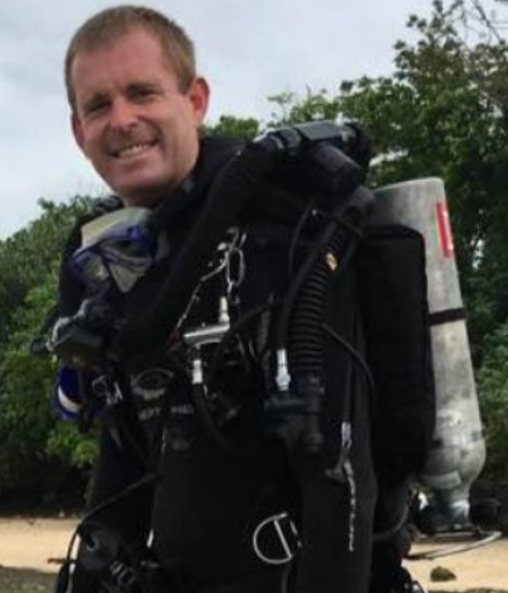
I am a 46 year old male who has been diving for 20 years.
I started CCR Diving in 2013 on the Poseidon MK VI Rebreather and began technical diving about a year later, completing ANDP Open Circuit and then 60m Normoxic Trimix on the Poseidon in 2014.
I moved to a JJ-CCR in 2018, completed 100m Hypoxic Trimix in early 2019 and have progressed my diving to reach increasing depths culminating in a 150m dive in September 2021. This was also coincidentally my 450th dive on the JJ-CCR.
The Poseidon CCR, does not allow the user to change the decompression algorithm, or add Gradient Factors. So to ensure my Shearwater and the Poseidon matched and got me out of the water at about the same time, I set the Shearwater to ZHL-16C with a GF of 45/85. I then continued to dive this same GF when I moved to the JJ-CCR.
From Feb. 2019 to Feb. 2021, I dived the JJ-CCR regularly to 60m and occasionally to 100m with no serious ill effect. I did have the occasional skin bend, an occasional little niggle in my left elbow, and regular fatigue after +60m dives. The niggles and skin bend were rare enough that I ignored them as part of diving and I just figured the fatigue to be normal. Then I got bent.
I did have the occasional skin bend, an occasional little niggle in my left elbow, and regular fatigue after +60m dives. The niggles and skin bend were rare enough that I ignored them as part of diving and I just figured the fatigue to be normal. Then I got bent.
In late February 2021, I got bent on a 60m dive. Upon exiting the water, my left arm was in a lot of pain and I had difficulty moving it. The symptoms did improve during the first hour out of the water, but I deteriorated quite quickly about 2 hours after leaving the water. I was driven to the Hyperbaric chamber by a friend and completed a Table 6 treatment that evening, with an O2 washout the next day, which completely resolved any symptoms. As the doctor said “No bend is a minor bend, but this was on the less serious end of the scale”. So after some PFO tests, a Coronary/Pulmonary CT Angiogram and a couple of consults with various professionals, I was cleared to continue diving.
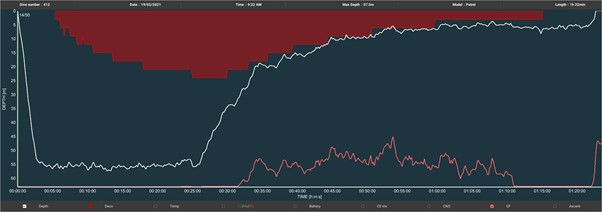
For reference here is the dive I got bent on. Not the cleanest deco to be honest, but there was a 2-3m swell and it was open ocean. The last stop in the computer was 3m, but it was not practical to maintain that depth. Overall nothing remarkable to write home about.
Roll forward to May 2021 and I am at Christmas Island doing some planned 100-120m dives. Dolphin Scuba has purchased the first O’Dive system in Australia with the Diving Center & Instructor Unlimited offer to allow everyone to analyse their dives.
Despite having modified my Gradient Factors to 50/75, the first O’Dive analysis told me I still had a long way to go. In fact when I sent this graph to Marc Crane to see what he could suggest, his comment was “Holy Smokes….. That’s a record Low”. The question was: “What to do about it?”
In the graph to the right:
- Sc = 41 shows the intrisic risk of the dive (Severity component)
- Bc = 40 is the highest possible value for the Bubble component
- Quality Index = 19 shows that the decompression quality for that dive was pretty poor
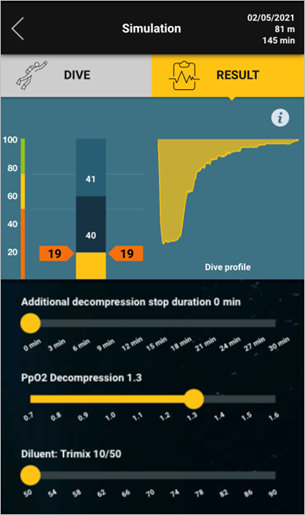
More information about the Quality Index and the different components is available at this page.
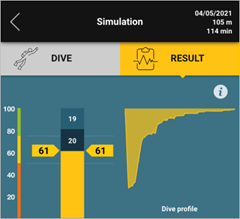
Using the simulation tool, and advice/suggestions from other divers and instructors, I was able to significantly improve my QI. Anecdotally, I felt much less tired after subsequent – even deeper – dives.
The dive here, a few days later, shows a marked improvement in the number of bubbles detected (Bc of 20 down from 40) and a greater than 10 times improvement in decompression quality.
There is still work to be done here though.
Between May 2021 and September 2021, I continued to dive regularly and work on improving my decompression procedures.
In September 2021 I was fortunate to find myself back on Christmas Island with access to O’Dive again, and the results were extremely encouraging.
Working on 50/70 as my standard GF I was also incorporating the following in my dives:
- Gradually flushing the CCR Loop with 32% from 40m-30m on the way up to remove any helium (but leaving the computer on the same trimix diluent setting)
- Flushing with O2 at 6m
- 5 minute ascent from the 6m stop to the 3m stop
- 5 minute ascent from 3m to the surface
- 3-5 minutes on loop breathing 100% O2 on the surface after exiting the water
- Maintaining 20m/minute descents and 10m/minute ascents
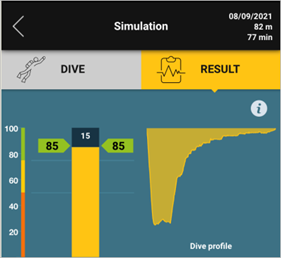

Two of my final 3 dives on Christmas Island were outside of the analysis range of the O’Dive for Quality Index (QI), which has a maximum depth of 125m.
But it still provides the bubble reading from the doppler which I found encouraging.
To conclude, O’Dive has without a doubt improved my decompression procedures. The bubble count, visual references, predictive sliders and other information from the app give instant feedback as to what is and is not working. I believe this has made me a safer diver and will hopefully avoid me getting bent again. As a bonus I am no longer feeling fatigued after big dives.
O’Dive goal is to enable divers to increase their self-knowledge and to promote safe behaviors while diving. It does not save in any way from the potential occurrence of decompression sickness.


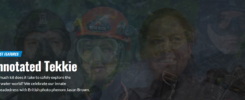
It was an interesting read. First of all, why would anyone accept occasional skin bend and fatigue as normal? One should not need a tool to recognise something is wrong there.
Flushing the loop with nitrox: one thought. In the article it says gradually flushing. This is super important, just in case someone forgets about isobaric counterdiffusion… It’s a very dangerous practice in my honest opinion. I think the modified GFs, the slow ascent at the end, O2 flush and breathing oxygen on the surface does the trick. I wouldn’t risk loading the loop with nitrogen and get ICD.
Thank you for sharing your story!